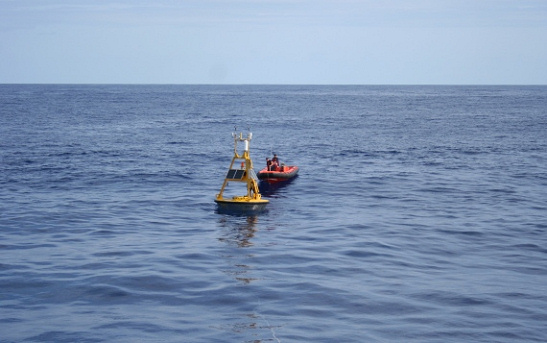Wave and weather forecasters in Hawaii will be able to gather more information from three new buoys deployed this week by the crew of the U.S. Coast Guard cutter Kukui, possibly improving surf reports for North-facing shores in the islands.
Crew members aboard the Honolulu-based buoy tender finished deploying three new weather buoys for the National Oceanic and Atmospheric Administration (NOAA) on Thursday, April 23.
The buoys will provide better wind and wave analysis for NOAA and should be available to the public as early as Sunday, April 26, at NOAA's National Data Buoy Center.
The buoys specifically help aid in forecasting incoming surf and weather in the Main Hawaiian Islands.
This week, the buoy tender crew established buoy 51001, which is 270 miles northwest of Oahu, and buoys 51000 and 51100, both 250 miles northeast of Oahu.
Buoys 51001, 51000, and 51100 will benefit a broad spectrum of islanders and businesses, including avid surfers, weekend beachgoers, inter-island shipping companies utilizing Kahului Harbor, and small businesses operating on north-facing shores.
According to James Wayman, meteorologist in charge at the National Weather Service Honolulu forecast office, the addition of buoys 51001, 51000, and 51100 significantly amplifies the NWS's ability to forecast weather, predict high surf, and monitor large storm systems.
"There was a gap to the northeast," says Wayman.
"These buoys will allow us to not only track weather but also monitor the wave height, wave period, and wave direction of incoming swell from the north."
Previously, there were only four NOAA buoys positioned around the islands.
As a result of their addition, the accuracy of forecasting for the north-facing shores of the Hawaiian Islands will significantly improve, says NOAA scientists.
Along with the standard weather systems that measure wind speed, wind direction, temperature, and barometric pressure, buoys 51001, 51000, and 51100 are equipped with sensors that measure wave height, period, and direction.
The relationship between accurate forecasting, the safety of life at sea, and the economy is critical, says Jeff Jenner, a manager at the National Data Buoy Center.
"Accurate wave and surf forecasts are critical to Hawaii's economy and to the safety of residents and tourists involved in surfing and other activities in the waters around the islands," Jenner said.
"Surfing alone draws tens of thousands of people to Oahu's North Shore each year and accounts for more than $10 million in direct benefit to the state's economy."
Data from the buoys will be available for viewing on the National Data Buoy Center's Web site, as early as Sunday.
Funding for the three new buoys came from special Congressional appropriation in 2008.
The Kukui is a 225-foot buoy tender with a crew of approximately 55.
In addition to servicing aids to navigation throughout Hawaii and the Pacific, the crew also performs law enforcement, marine pollution response, and search and rescue missions.
